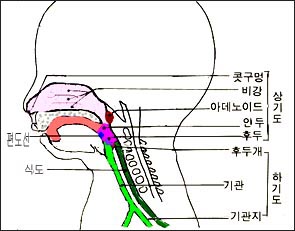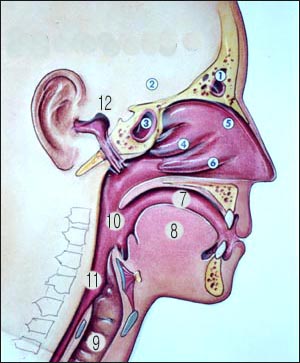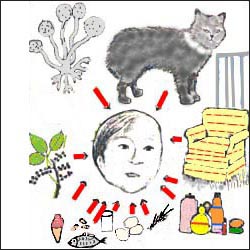알레르기 비염(알러지성 비염) 개요, allergic rhinitis definition
비강, 상기도, 하기도의 구조

그림 73. 비강, 상기도와 하기도의 해부도.
Copyright ⓒ 2011 John Sangwon Lee, MD., FAAP

그림 74. 비강, 부비동, 상하 호흡기 해부도
①전두동, ②뇌, ③접형동, ④상갑개, ⑤중 갑개, ⑥하 갑개 ⑦구강, ⑧혀, ⑨기관,⑩인두,⑪식도, ⑫중이, ⑫ 이관
Copyright ⓒ 2011 John Sangwon Lee, MD., FAAP
알레르기 비염의 개요
- 선진국에서 사는 성인들의 25%가 알레르기 비염으로 고생한다.
- 알레르기 비염으로 죽는 경우는 거의 없으나 그 병으로 소아청소년들이나 성인들의 일상 삶의 질에 부정적으로 많은 영향을 끼친다.
- 또 알레르기 비염의 병력을 가진 성인들과 소아청소년들에게 천식, 만성 비염, 부비동염, 중이염, 비용(코 폴립), 상기도 염 등이 더 잘 발생한다.
- 알레르기 비염은 친 부모 형제자매들에게도 흔히 나타난다.
- 알레르기 비염은 급성으로 한 번 생겼다가 없어지는 알레르기 질환이 아니다.
- 이 병의 증상 징후와 진단 치료도 복잡하다.
- 많은 사람들은 알레르기 비염의 증상 징후가 경미할 때 알레르기 비염을 숱하게 많은 사약으로 치료하고, 부모들과 환아 자신들이 약국에서 항히스타민제 등 여러 종류의 약을 의사 처방 없이 구입해 치료하기도 한다.
- 아주 심한 증상 징후가 있는 사람들은 코르티코스테로이드제로 치료하기도 하고,
- 항히스타민제와 코르티코스테로이드제로 치료하기도 하고,
- 일부 알레르기 비염은 약물로 잘 치료 되지 않아 알레르기 면역 치료로 치료하기도 한다.
- 요즘 알레르기 면역물질을 피부층에 주입해서 치료하는 대신 알레르기 면역물질을 혀 밑에 넣어 설 하 면역치료(Sublingual immunotherapy)를 해서 알레르기 비염을 면역치료를 하기도 한다.
- 알레르기 비염은 비강 점막층에 생긴 알레르기 질환이다. 즉 면역체 IgE 중개로 생기는 비강점막층 염증성 질환의 일종이다.
표 1. 미 소아청소년(0~18세)들에게 생긴 알레르기 비염과 알레르기 질환 통계
|
|
13,579명의 미 소아청소년들을 상대로 조사한 자료에서 추정한 수
출처 : 미 CDC 및 예방
- 숨 쉴 때 콧구멍을 통해 비강 내로 직접 흡인 된
-
- 화분(꽃가루),
- 집 먼지 진드기(집 먼지 좀 진드기),
- 짐승의 털이나 비듬,
- 새 깃털,
- 그 외 항원과 비강 점막층에 있는 항체가 결합해 이상반응을 일으킬 때 알레르기 비염 이 생긴다.
- 또 경구를 통해 섭취한 음식물 단백질 성분이 위장관 점막층을 통해서 피 속으로 흡수된 후 비강 내 점막층에 도착하게 된다.
- 그 단백질의 성분, 즉 비강 점막층에 이미 있는 항체가 서로 결합해 이상반응을 일으킬 때 알레르기 비염이 생길 수 있다.
- 다시 설명하면, 호흡기의 기도의 점막층, 소화기계 위장관의 점막층이나 피부층을 통해 신체 내로 들어온 항원이 비강 내 점막층에서 IgE 항체를 만나 항원 항체 이상 반응이 비강 점막층에 생길 때 알레르기 비염이 비강 점막층에서 생길 수 있다.
- 환아 자신은 물론이고, 부모들은 알레르기 비염의 정의, 원인, 증상 징후, 진단 치료, 예방 등에 관해 가능한 한 많이 알아둘 필요가 있다.

그림 74-1 알레르기 비염을 유발 시킬 수 있는 있는 항원(알러젠 Allergen)-
곰팡이, 몰드, 고양이, 개, 새, 풀이나 나무의 꽃가루, 두류, 달걀, 우유, 생선, 화장품, 약물, 집 먼지 진드기(집 먼지 좀 진드기) 등. 여기에 있는 얼굴형을 아데노이드“안모”라고 한다.
Copyright ⓒ 2011 John Sangwon Lee, MD., FAAP
알레르기 비염의 증상 징후의 요약
- 비강 점막층이 붓고,
- 비강의 점막층 모세혈관이 확장되고 충혈되고,
- 콧물이 나고,
- 코가 가렵고,
- 눈이 붉고, 가렵고, 붓고
- 코가 막히고,
- 입을 벌리고 입으로 숨을 쉬고,
- 알레르기 설루트(Salute), 알레르기 샤이너(Allergic shinners), 데니스 몰간 주름살 등 증상 징후가 눈꺼풀 가장자리에 생길 수 있다.
- 알레르기 비염이 있는 아이들에게 이상 설명한 여러 가지 알레르기 비염의 증상 징후가 나타나고,
- 학습 장애,
- 집중력 결여증(주의력 결핍장애) 및, 또는 과도 활동장애,
- 수면장애,
- 수면 중 차단성 무호흡증,
- 코골이 등의 증상 징후가 생길 수 있다.
- 알레르기 비염이 있는 아이들에게 부비동염 및, 또는 천식, 눈 알레르기, 중이염 등이 동시 생기기도 한다. 더 구체적으로 설명한다.
알레르기 비염의 발병 빈도
- 미국 전 연령층의 15∼22%가 알레르기 비염으로 고생한다.
- 미국 연구에 의하면 알레르기 비염으로 년 4억 5천만 달러의 진료비가 소요됐고
- 미국 사람들의 8.8~16%가 알레르기 비염을 앓고 있다고 한다.
- 미국 사춘기 이전 소아들의 10%에게 알레르기 비염이 있다.
- 호흡기에 생기는 만성 질환들 중 가장 흔한 질환이 바로 알레르기 비염이다.
- 미국 사춘기 아이들과 젊은이들의 20%가 알레르기 비염을 앓고 있다고 한다.
다음은 알레르기 비염의 원인과 유발 인자로 이어짐
Overview of allergic rhinitis, allergic rhinitis definition
Structure of the nasal cavity, upper and lower respiratory tract

Figure 73. Anatomy of the nasal cavity, upper and lower airways. Copyright ⓒ 2011 John Sangwon Lee, MD., FAAP

Figure 74. Anatomy of the nasal cavity, sinuses, and upper and lower respiratory tract
① frontal sinus,
② brain,
③ sphenoid sinus,
④ superior turbinate,
⑤ middle turbinate,
⑥ inferior turbinate
⑦ oral cavity,
⑧ tongue,
⑨ trachea,
⑩ pharynx,
⑪ esophagus,
⑫ middle ear,
⑫ ear tube
Copyright ⓒ 2011 John Sangwon Lee, MD., FAAP
Overview of Allergic Rhinitis
• 25% of adults living in developed countries suffer from allergic rhinitis.
• Death from allergic rhinitis is rare, but the disease negatively affects the quality of daily life of children, adolescents and adults.
• Adults and children with a history of allergic rhinitis are also more likely to develop asthma, chronic rhinitis, sinusitis, otitis media, nasal polyps, and upper respiratory tract infections.
• Allergic rhinitis is also common among siblings.
• Allergic rhinitis is not an acute, one-time allergic disease.
• Symptomatic signs and diagnosis and treatment of the disease are also complex.
• Many people treat allergic rhinitis with a lot of herbal medicines when the symptoms of allergic rhinitis are mild, and parents and children themselves buy various types of medicines, such as antihistamines, from pharmacies without a doctor’s prescription.
• People with very severe symptoms are sometimes treated with corticosteroids;
• Sometimes treated with antihistamines and corticosteroids;
• Some allergic rhinitis is not treated well with drugs, so it is treated with allergic immunotherapy.
• These days, instead of injecting an allergy immune substance into the skin layer to treat it, sublingual immunotherapy is sometimes used to treat allergic rhinitis by putting an allergy immune substance under the tongue.
• Allergic rhinitis is an allergic disease of the nasal mucosa. That is, it is a kind of inflammatory disease of the nasal mucosa caused by IgE mediation of the immune system. ‘
Table 1. Statistics on allergic rhinitis and allergic diseases in US children and adolescents (0-18 years old)

Estimated from data of 13,579 American children and adolescents Source: US CDC and Prevention
• Aspirated directly into the nasal cavity through the nostrils when breathing
• o pollen (pollen),
o house dust mites (house dust mites),
o Animal hair or dander;
o bird feathers,
o Allergic rhinitis occurs when other antigens and antibodies in the nasal mucosa combine to cause an adverse reaction.
• In addition, food protein components ingested orally are absorbed into the blood through the mucosal layer of the gastrointestinal tract and arrive at the mucosal layer in the nasal cavity.
• Allergic rhinitis may occur when the components of the protein, that is, antibodies already in the nasal mucosa, bind to each other and cause an adverse reaction.
• In other words, when an antigen that enters the body through the mucosal layer of the respiratory tract, the mucous membrane or the skin layer of the gastrointestinal tract of the digestive system meets IgE antibodies in the mucosal layer in the nasal cavity, an adverse antigen-antibody reaction occurs in the nasal mucosa layer. can
• Parents, as well as the child themselves, need to know as much as possible about the definition, causes, symptoms, diagnosis, treatment, and prevention of allergic rhinitis.

Figure 74-1 Allergen that can cause allergic rhinitis- Mold, mold, cat, dog, bird, grass or tree pollen, beans, eggs, milk, fish, cosmetics, drugs, house dust mites (house dust mites), etc. This face shape is called adenoid “face”. Copyright ⓒ 2011 John Sangwon Lee, MD., FAAP
Summary of Symptoms, Signs of Allergic Rhinitis
• swelling of the nasal mucosa;
• The mucosal capillaries of the nasal passages are enlarged and congested;
• runny nose,
• Itchy nose,
• Red, itchy, swollen eyes
• stuffy nose,
• Open your mouth and breathe through your mouth,
• Allergic salutes, Allergic shiners, Denise Morgan wrinkles, and other symptoms may appear on the edges of the eyelids.
• Children with allergic rhinitis have various symptoms of allergic rhinitis described above,
• learning disabilities;
• attention deficit disorder (attention deficit disorder) and, or hyperactivity disorder;
• sleep disorders;
• Obstructive apnea during sleep;
• Symptoms such as snoring may occur.
• Children with allergic rhinitis may develop sinusitis and/or asthma, eye allergy, and otitis media at the same time. More specifically.
Frequency of occurrence of allergic rhinitis
• 15-22% of Americans of all ages suffer from allergic rhinitis.
• A US study found that allergic rhinitis costs $450 million a year for medical care.
• It is reported that 8.8-16% of Americans suffer from allergic rhinitis.
• 10% of prepubertal children in the United States have allergic rhinitis
• Allergic rhinitis is the most common among chronic respiratory diseases.
• It is reported that 20% of adolescents and young adults in the United States suffer from allergic rhinitis.
The following leads to the causes and triggers of allergic rhinitis
출처 및 참조 문헌 Sources and references
- NelsonTextbook of Pediatrics 22ND Ed
- The Harriet Lane Handbook 22ND Ed
- Growth and development of the children
- Red Book 32nd Ed 2021-2024
- Neonatal Resuscitation, American Academy Pediatrics
- A SUPPLEMENT TO PEDIATRICS, SYNAPSIS BOOK, BEST ARTICLES RELEVANT TO PEDIATRIC ALLERGY, ASTHMA, IMMUNOLOGY, PEDIATRICS OFFICIAL JOURNAL OF THE AMERICAN ACADEMY.12/2019
- Pediatrics, December 2021-Supplement to pediatrics- best article relate to pediatric allergy , asthma, immunology
- www.drleepediatrics.com 제1권 소아청소년 응급 의료
- www.drleepediatrics.com 제2권 소아청소년 예방
- www.drleepediatrics.com 제3권 소아청소년 성장 발육 육아
- www.drleepediatrics.com 제4권 모유,모유수유, 이유
- www.drleepediatrics.com 제5권 인공영양, 우유, 이유식, 비타민, 미네랄, 단백질, 탄수화물, 지방
- www.drleepediatrics.com 제6권 신생아 성장 발육 육아 질병
- www.drleepediatrics.com제7권 소아청소년 감염병
- www.drleepediatrics.com제8권 소아청소년 호흡기 질환
- www.drleepediatrics.com제9권 소아청소년 소화기 질환
- www.drleepediatrics.com제10권. 소아청소년 신장 비뇨 생식기 질환
- www.drleepediatrics.com제11권. 소아청소년 심장 혈관계 질환
- www.drleepediatrics.com제12권. 소아청소년 신경 정신 질환, 행동 수면 문제
- www.drleepediatrics.com제13권. 소아청소년 혈액, 림프, 종양 질환
- www.drleepediatrics.com제14권. 소아청소년 내분비, 유전, 염색체, 대사, 희귀병
- www.drleepediatrics.com제15권. 소아청소년 알레르기, 자가 면역질환
- www.drleepediatrics.com제16권. 소아청소년 정형외과 질환
- www.drleepediatrics.com제17권. 소아청소년 피부 질환
- www.drleepediatrics.com제18권. 소아청소년 이비인후(귀 코 인두 후두) 질환
- www.drleepediatrics.com제19권. 소아청소년 안과 (눈)질환
- www.drleepediatrics.com 제20권 소아청소년 이 (치아)질환
- www.drleepediatrics.com 제21권 소아청소년 가정 학교 간호
- www.drleepediatrics.com 제22권 아들 딸 이렇게 사랑해 키우세요
- www.drleepediatrics.com 제23권 사춘기 아이들의 성장 발육 질병
- www.drleepediatrics.com 제24권 소아청소년 성교육
- www.drleepediatrics.com 제25권 임신, 분만, 출산, 신생아 돌보기
- Red book 29th-31st edition 2021
- Nelson Text Book of Pediatrics 19th- 21st Edition
- The Johns Hopkins Hospital, The Harriet Lane Handbook, 22nd edition
- 응급환자관리 정담미디어
- Pediatric Nutritional Handbook American Academy of Pediatrics
- 소아가정간호백과–부모도 반의사가 되어야 한다, 이상원 저
- The pregnancy Bible. By Joan stone, MD. Keith Eddleman, MD
- Neonatology Jeffrey J. Pomerance, C. Joan Richardson
- Preparation for Birth. Beverly Savage and Dianna Smith
- 임신에서 신생아 돌보기까지. 이상원
- Breastfeeding. by Ruth Lawrence and Robert Lawrence
- Sources and references on Growth, Development, Cares, and Diseases of Newborn Infants
- Emergency Medical Service for Children, By Ross Lab. May 1989. p.10
- Emergency care, Harvey Grant and Robert Murray
- Emergency Care Transportation of Sick and Injured American Academy of Orthopaedic Surgeons
- Emergency Pediatrics A Guide to Ambulatory Care, Roger M. Barkin, Peter Rosen
- Quick Reference To Pediatric Emergencies, Delmer J. Pascoe, M.D., Moses Grossman, M.D. with 26 contributors
- Neonatal resuscitation Ameican academy of pediatrics
- Pediatric Nutritional Handbook American Academy of Pediatrics
- Pediatric Resuscitation Pediatric Clinics of North America, Stephen M. Schexnayder, M.D.
-
Pediatric Critical Care, Pediatric Clinics of North America, James P. Orlowski, M.D.
-
Preparation for Birth. Beverly Savage and Dianna Smith
-
Infectious disease of children, Saul Krugman, Samuel L Katz, Ann A.
- 제4권 모유, 모유수유, 이유 참조문헌 및 출처
- 제5권 인공영양, 우유, 이유, 비타민, 단백질, 지방 탄수 화물 참조문헌 및 출처
- 제6권 신생아 성장발육 양호 질병 참조문헌 및 출처
- 소아과학 대한교과서